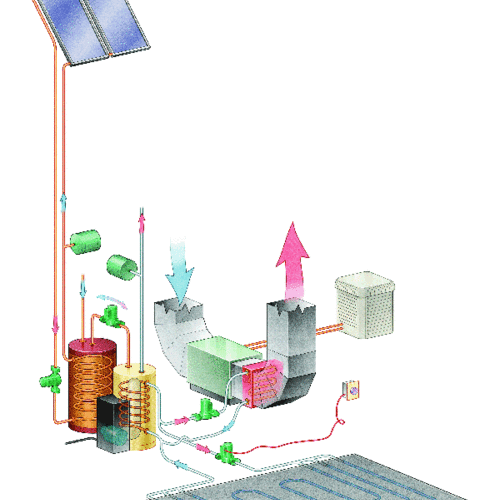ABOUT HEAT DISTRIBUTION SYSTEMS
One form of heat (and its distribution system) is not necessarily any better or more efficient than another. Overall system performance depends on factors ranging from the price of fuel to the efficiency of the heating system to how it’s installed.
Heat can be generated by a variety of fuels and is usually distributed to individual rooms by either forced-air ductwork or hydronic (water-filled) pipes. However, some well insulated houses may not need any heat distribution system at all, relying instead on a centrally located woodstove or on individual space heaters.
European Standard for Low-Energy-Use Buildings
Most European homes built to the German Passivhaus standard distribute heat through ventilation ducts rather than hydronic pipes or conventional ductwork. Such homes include a heat-recovery ventilator with ventilation ducts measuring 4 inches or less in diameter.
The homes are built to a high standard of air tightness and include thick layers of insulation and triple-glazed windows; as a result, very little space heating is required. Space heat needs are supplied through the HRV’s ductwork by an electric resistance heater, an air-source heat pump that scavenges heat from the ventilation system’s exhaust air stream, or a hydronic coil connected to a water heater.
For more information on the Passivhaus standard, see “Passivhaus for Beginners.”

This article is only available to GBA Prime Members
Sign up for a free trial and get instant access to this article as well as GBA’s complete library of premium articles and construction details.
Start Free TrialAlready a member? Log in















3 Comments
conversion
I want to replace my 30 year old furnace and water heater. They are next to each other in a closet. Can I use a tankless water heater and a hydro system to blow the hot air through the existing air ducts? Thanks in advance--jerry
Response to Jerry
Jerry,
The short answer is, "Yes, but such systems are complicated and problematic, and the installer needs to know what he or she is doing."
If you have located an installer who is willing to do this:
1. Ask how many such systems have been installed, and ask for a reference so you can speak with the homeowners living with such a system; and
2. Contact a technical rep at the manufacturer of the tankless water heater you intend to use and ask whether the unit is suitable for space heating. Some are and some aren't.
lifebreath clean air furnaces
Martin and Jerry,
Jerry's desire is not as complicated as you suggest. Airia, a Canadian company, has been manufacturing an hydronic forced air unit with built-in ERV or HRV and ECM motors for at least two decades. They typically are supplied with hot-water from standard tank-style hot water heaters, but can also work with boilers or on-demand heaters or even solar panels. We put 25 systems in new construction in 2008, but I have always believed their best application would be for exactly what Jerry wants to do. The old exhaust and supply air holes for a gas fired heater potentially can be used for the supply and exhaust of the ERV. I keep waiting for a GBA in-depth article on hydronic forced air heating, especially with a solar panel helping to supply the BTUs.
Log in or become a member to post a comment.
Sign up Log in